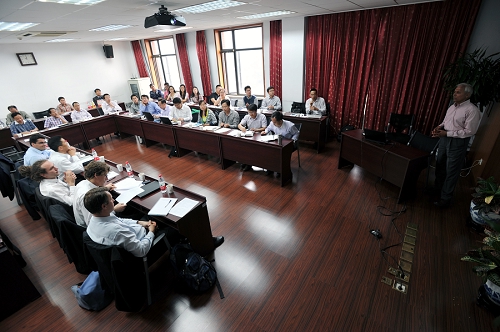On September 22, 2014, a seminar on concentrating solar power (CSP) technology was held at IEECAS. Almost fifty experts and researchers from Sandia National Laboratories (SNL), Australia National University (ANU) and Institute of Electrical Engineering Chinese Academy of Sciences (IEECAS) attended the seminar.
The seminar starts with a welcoming speech by Prof. Zhifeng Wang, the director of the renewable energy department of IEECAS. He pointed out this seminar aimed to exchange academic ideas on CSP technology and explore the possible collaborations among three teams.
On behalf of IEE, SNL and ANU respectively, Prof. Zhifeng Wang, Dr. Subhash Shinde and Dr. John Pye presented the overview of CSP programs and facilities, which included research directions, achievements and future works. Then Dr. Clifford Ho presented the advanced technology for next generation falling particle receivers. Dr. Joe Coventry reviewed the state-of-the-art receiver technology and analyzed the potential for its improvement. Dr. Fengwu Bai introduced the research progress on solar air receiver of IEECAS. To optimize the performance of receivers, Dr. Clifford Ho developed fractal-like designs and structures to increase solar absorptance while minimizing heat loss. Mr.Charles-Alexis Asselineau optimized the cavity shape via stochastic optimization integrated with ray tracing. For the thermal performance analysis and measurement, Dr. Xin Li, Dr. John Pye and Mr. Ehsan Abbasi introduced their work with molten salt receiver, tubular receiver and cylindrical cavity receiver, respectively. With the regard of the heliostat technology, the hot topics included automated heliostat tracking correction method, tracking accuracy analysis, development of future heliostats, reflective surface shape measurement, and so on.
At last, the three teams explored and discussed about the possible collaborations, which laid the foundation for cooperative research on CSP technology in the future.


